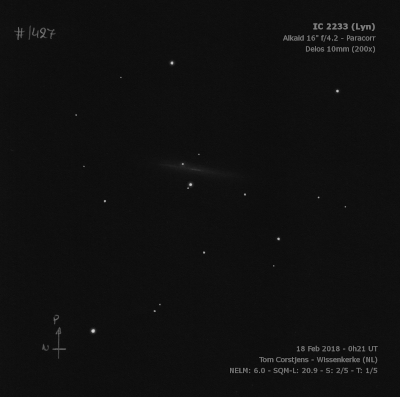
Isaac Roberts discovered IC 2233 photographically on 25 Mar 1894 using the 20" reflector at his "Starfield" observatory in Sussex, England. Based on plates taken with the 60-inch at Mt. Wilson, Pease described (1920) the nebula as a "faint edge-on spiral, 240"x10", p.a. 170°, with a faint stellar nucleus."
400/500mm - 17.5" (2/24/90): very faint, moderately large, extremely thin edge-on NNW-SSE with a low even surface brightness. A mag 14 star is embedded at the north tip and a mag 11/14 double star at 13" separation is off the east side 1.0' from center. Located 17' SSE of NGC 2537. This galaxy is one of the thinnest known.
900/1200mm - 48" (4/15/10): this remarkably thin, beautiful superthin edge-on extends 4.0'x0.25' (~15:1 axial ratio) NNW-SSE. Contains a brighter elongated central region with a slightly brighter nucleus (though no bulge). The overall surface brightness is fairly low and the galaxy gradually dims near the ends of the extensions. The center is situated only 0.9' SW of a mag 10 double (a mag 13.5 companion lies 13" away) and the orientation aligns with the center of the galaxy. Roughly midway along the northern extension is a mag 14 star. Beyond this star the galaxy gradually fades to the tip, extending to within 0.6' of a faint star off the NNW tip. On the south extension, the galaxy also fades, but after nearly dimming out there is a feeble glow at the very tip that is slightly angled or bent towards the east. Located 17' SE of the Bear-Paw galaxy.
Notes by Steve Gottlieb